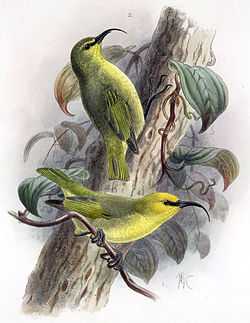Maui Nukupuʻu
| Maui Nukupuʻu | |
|---|---|
 | |
| Painting by Keulemans | |
| Conservation status | |
| Scientific classification | |
| Kingdom: | Animalia |
| Phylum: | Chordata |
| Class: | Aves |
| Order: | Passeriformes |
| Family: | Fringillidae |
| Subfamily: | Carduelinae |
| Genus: | Hemignathus |
| Species: | H. lucidus |
| Subspecies: | H. l. affinis |
| Trinomial name | |
| Hemignathus lucidus affinis (Rothschild, 1893 | |
The Maui Nukupuʻu (Hemignathus lucidus affinis) is subspecies of Nukupu‘u that was endemic to the island of Maui in the Hawaiian Islands. The small, five inch long bird lives only in eastern Maui, where it is dependent on high-elevation mesic and wet forests of ʻōhiʻa lehua (Metrosideros polymorpha) and koa (Acacia koa). These two species of trees attract insects, causing the Maui Nukupuʻu to have a higher chance of finding a meal near these trees.
Appearance

The males are colored green on the back and head, and yellow on its neck, belly and bottom. The females are completely olive green and are quieter than their male counterparts. Juveniles are grey and green. The bird's long bill is used to peck out insects in the tree's bark. The bill is an inch long and takes up to 1/3 or more of its entire length.
Population
This species existed in the Hanawi Area Reserve from 3,000 feet up to 4,500 feet up. It formally survived at lower elevations and even in West Maui. It has only been sighted a few times in the 20th century. It was common in the 1900s, but by 1963 it was thought to be extinct. However, a rediscovery of the species in 1980 proved that the species survived. By the 1980s, the population was thought to be 28 birds as a best estimate.[citation needed] By 1994, that figure dropped down to only one or so birds, a male was sighted but was never seen again. There have been reports of this bird even in 2007; however, it seems that the birds are only Common ʻAmakihi.[citation needed]
References
- BirdLife International 2004. Hemignathus lucidus affinis. 2006 IUCN Red List of Threatened Species. Downloaded on 10 July 2007.
External links
- BirdLife Species Factsheet
- 3D view of specimen RMNH 110.002 at Naturalis, Leiden (requires QuickTime browser plugin).
- "Maui Nuku Puʻu" (PDF). Hawaii’s Comprehensive Wildlife Conservation Strategy. State of Hawaiʻi. 2005-10-01.
